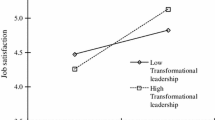Abstract
Recent research in organizational psychology has recognized the value of exploring the person-situation interactional perspective as a determinant of work outcomes. The present field study investigated the interaction between self-leadership and work structure (supervisory structure and job autonomy) and their relation to job satisfaction. Seventy-six employees provided measures of self-leadership, employment characteristics, and job satisfaction. Performance data for participants was also collected from the organization. Satisfaction was higher for employees with high (low) self-leadership who worked in low (high) structure environments. These results suggest that affective response to the job may be influenced by specific combinations of person and situation variables. Implications of the current results with regard to person-environment fit are discussed.
Similar content being viewed by others
REFERENCES
Ball, G. A., Trevino, L. K., & Sims, H. P. (1991). “Just” and “unjust” organizational punishment: Influences on subordinate performance and citizenship behavior. Unpublished manuscript.
Bandura, A. (1977). Social learning theory. Englewood Cliffs, NJ: Prentice Hall.
Cook, J. D., Hepworth S. J., Wall, T. D., & Warr, P. B. (1981). The experience of work: A compendium and review of 249 measures and their use. New York: Academic Press.
Cox, J. F., (1993). The effects of superleadership training on leader behavior, subordinate self-leadership behavior, and subordinate citizenship. Unpublished doctoral dissertation proposal, University of Maryland, College Park, MD.
Deci, E. L. (1975). Intrinsic motivation. New York: Plenum.
George, J. (1992). The role of personality in organizational life: Issues and evidence. Journal of Management, 18, 185–213.
Ghiselli, E. E., Campbell, J. P., & Zedeck, S. (1981). Measurement theory for the behavioral sciences. San Francisco: W. H. Freeman and Company.
Hackman, J. R., & Oldham, G. R. (1975). Development of the job diagnostic survey. Journal of Applied Psychology, 60, 159–170.
Hackman, J. R., & Oldham, G. R. (1976). Motivation through the design of work: Test of a theory. Organizational Behavior and Human Performance, 16, 250–279.
Hackman, J. R., & Oldham, G. R. (1980). Work redesign. Reading, Mass.: Addison-Wesley.
Hanges, P. J., Schneider, B. & Niles, K. (1990). Stability of performance: An interactionist perspective. Journal of Applied Psychology, 75, 658–667.
Hauenstein, N. M. A., & Bittle, M. L. (1990). Task characteristics as a moderator of the disposition/job satisfaction relationship. Paper presented at the annual meeting of the Society for Industrial and Organizational Psychology, Miami Beach, FL.
House, R. J. (1971). A path goal theory of leader effectiveness. Administrative Science Quarterly, 16, 321–338.
Judge, T. A. (1992). The dispositional perspective in human resources research. In G. R. Ferris and K. M. Rowland (Eds.), Research in Personnel and Human Resources Management (Vol. 10, pps. 31–72). Greenwich, CT: JAI Press.
Judge, T. A. (1993). Does affective disposition moderate the relationship between job satisfaction and voluntary turnover? Journal of Applied Psychology, 78, 395–401.
Judge, T. A., & Hulin, C. L. (1993). Job satisfaction as a reflection of disposition: A multiple source causal analysis. Organizational Behavior and Human Decision Processes, 56, 388–421.
Judge, T. A., & Locke, E. A. (1993). Effect of dysfunctional though processes on subjective wellbeing and job satisfaction. Journal of Applied Psychology, 78, 475–490.
Judge, T. A., & Watanabe, S. (1993). Another look at the job satisfaction-life satisfaction relationship. Journal of Applied Psychology, 78, 939–948.
Kerr, S., Schriesheim, C. A., Murphy, C. J., Stogdill, T. M. (1974). Toward a contingency theory of leadership based upon the consideration and initiating structure literature. Organizational Behavior and Human Performance, 12, 62–82.
Kulik, C. T., Oldham, G. R., & Hackman, J. R. (1987). Work design as an approach to person-environment fit. Journal of Vocational Behavior, 31, 278–296.
Levin, I., & Stokes, J. P. (1989). Dispositional approach to job satisfaction: Role of negative affectivity. Journal of Applied Psychology, 74, 752–758.
Manz, C. C. (1983). The art of self-leadership. Englewood Cliffs, NJ: Prentice-Hall.
Manz, C. C. (1986). Self-leadership: Toward an expanded theory of self-influence processes in organizations. Academy of Management Review, 11(3), 585–600.
Manz, C. C. (1992). Mastering self-leadership: Empowering yourself for personal excellence. New York: Prentice-Hall.
Manz, C. C., & Sims, H. P., Jr. (1987). Leading workers to lead themselves: The external leadership of self-managed work teams. Administrative Science Quarterly, 32, 106–128.
Manz, C. C., & Sims, H. P., Jr. (1989). SuperLeadership: Leading others to lead themselves. New York: Berkeley Books.
Markham, S. E., Markham, I. S., & Neck, C. P. (1995). Self-management and self-leadership re-examined: A levels of analysis perspective. Leadership Quarterly, 6.
Pervin, L. A. (198S). Personality: Current controversies, issues, and directions. Annual Review of psychology, 36, 83–114.
Pervin, L. A. (1989). Persons, situations, interactions: The history of a controversy and a discussion of theoretical models. Academy of Management Review, 14, 350–360.
Rain, J. S., Lane, I. M., & Steiner, D. D. (1991). A current look at the job satisfaction/life satisfaction relationship: Review and future considerations. Human Relations, 44, 287–307.
Salancik, G. R., & Pfeffer, J. (1978). A social information processing approach to job attitudes and task design. Administrative Science Quarterly, 23, 224–253.
Schneider, B. (1987). The people make the place. Personnel Psychology, 40, 437–453.
Schneider, B. (1987a). E = f(P,B): The road to a radical approach to person-environment fit. Journal of Vocational Behavior, 31, 353–361.
Staw, B. M., Bell, N. E., & Clausen, J. A. (1986). The dispositional approach to job attitudes. Journal of Applied Psychology, 73, 11–19.
Staw, B. M., & Ross, J. (1985). Stability in the midst of change: A dispositional approach to job attitudes. Journal of Applied Psychology, 70, 469–480.
Stogdill, R. M. (1963). Manual for the Leader Behavior Description Questionnaire—Form XII. Columbus: Bureau of Business Research, The Ohio State University.
Weiss, D. J., Dawis, R. V., England, G. W., & Lofquist, L. H. (1967). Manual for the Minnesota Satisfaction Questionnaire. Minneapolis: University of Minnesota, Industrial Relations Center.
Author information
Authors and Affiliations
Rights and permissions
About this article
Cite this article
Roberts, H.E., Foti, R.J. Evaluating the Interaction Between Self-Leadership and Work Structure in Predicting Job Satisfaction. Journal of Business and Psychology 12, 257–267 (1998). https://doi.org/10.1023/A:1025067128193
Issue Date:
DOI: https://doi.org/10.1023/A:1025067128193




